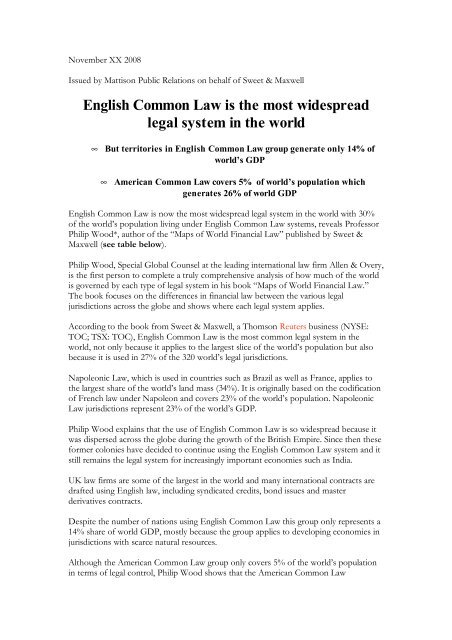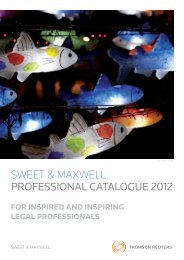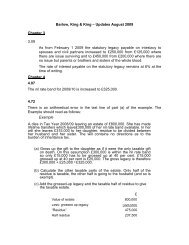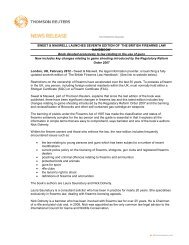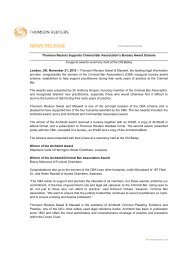English Common Law is the most widespread legal system in the world
English Common Law is the most widespread ... - Sweet & Maxwell
English Common Law is the most widespread ... - Sweet & Maxwell
Create successful ePaper yourself
Turn your PDF publications into a flip-book with our unique Google optimized e-Paper software.
November XX 2008Issued by Matt<strong>is</strong>on Public Relations on behalf of Sweet & Maxwell<strong>Engl<strong>is</strong>h</strong> <strong>Common</strong> <strong>Law</strong> <strong>is</strong> <strong>the</strong> <strong>most</strong> <strong>widespread</strong><strong>legal</strong> <strong>system</strong> <strong>in</strong> <strong>the</strong> <strong>world</strong>∞ But territories <strong>in</strong> <strong>Engl<strong>is</strong>h</strong> <strong>Common</strong> <strong>Law</strong> group generate only 14% of<strong>world</strong>’s GDP∞ American <strong>Common</strong> <strong>Law</strong> covers 5% of <strong>world</strong>’s population whichgenerates 26% of <strong>world</strong> GDP<strong>Engl<strong>is</strong>h</strong> <strong>Common</strong> <strong>Law</strong> <strong>is</strong> now <strong>the</strong> <strong>most</strong> <strong>widespread</strong> <strong>legal</strong> <strong>system</strong> <strong>in</strong> <strong>the</strong> <strong>world</strong> with 30%of <strong>the</strong> <strong>world</strong>’s population liv<strong>in</strong>g under <strong>Engl<strong>is</strong>h</strong> <strong>Common</strong> <strong>Law</strong> <strong>system</strong>s, reveals ProfessorPhilip Wood*, author of <strong>the</strong> “Maps of World F<strong>in</strong>ancial <strong>Law</strong>” publ<strong>is</strong>hed by Sweet &Maxwell (see table below).Philip Wood, Special Global Counsel at <strong>the</strong> lead<strong>in</strong>g <strong>in</strong>ternational law firm Allen & Overy,<strong>is</strong> <strong>the</strong> first person to complete a truly comprehensive analys<strong>is</strong> of how much of <strong>the</strong> <strong>world</strong><strong>is</strong> governed by each type of <strong>legal</strong> <strong>system</strong> <strong>in</strong> h<strong>is</strong> book “Maps of World F<strong>in</strong>ancial <strong>Law</strong>.”The book focuses on <strong>the</strong> differences <strong>in</strong> f<strong>in</strong>ancial law between <strong>the</strong> various <strong>legal</strong>jur<strong>is</strong>dictions across <strong>the</strong> globe and shows where each <strong>legal</strong> <strong>system</strong> applies.Accord<strong>in</strong>g to <strong>the</strong> book from Sweet & Maxwell, a Thomson Reuters bus<strong>in</strong>ess (NYSE:TOC; TSX: TOC), <strong>Engl<strong>is</strong>h</strong> <strong>Common</strong> <strong>Law</strong> <strong>is</strong> <strong>the</strong> <strong>most</strong> common <strong>legal</strong> <strong>system</strong> <strong>in</strong> <strong>the</strong><strong>world</strong>, not only because it applies to <strong>the</strong> largest slice of <strong>the</strong> <strong>world</strong>’s population but alsobecause it <strong>is</strong> used <strong>in</strong> 27% of <strong>the</strong> 320 <strong>world</strong>’s <strong>legal</strong> jur<strong>is</strong>dictions.Napoleonic <strong>Law</strong>, which <strong>is</strong> used <strong>in</strong> countries such as Brazil as well as France, applies to<strong>the</strong> largest share of <strong>the</strong> <strong>world</strong>’s land mass (34%). It <strong>is</strong> orig<strong>in</strong>ally based on <strong>the</strong> codificationof French law under Napoleon and covers 23% of <strong>the</strong> <strong>world</strong>’s population. Napoleonic<strong>Law</strong> jur<strong>is</strong>dictions represent 23% of <strong>the</strong> <strong>world</strong>’s GDP.Philip Wood expla<strong>in</strong>s that <strong>the</strong> use of <strong>Engl<strong>is</strong>h</strong> <strong>Common</strong> <strong>Law</strong> <strong>is</strong> so <strong>widespread</strong> because itwas d<strong>is</strong>persed across <strong>the</strong> globe dur<strong>in</strong>g <strong>the</strong> growth of <strong>the</strong> Brit<strong>is</strong>h Empire. S<strong>in</strong>ce <strong>the</strong>n <strong>the</strong>seformer colonies have decided to cont<strong>in</strong>ue us<strong>in</strong>g <strong>the</strong> <strong>Engl<strong>is</strong>h</strong> <strong>Common</strong> <strong>Law</strong> <strong>system</strong> and itstill rema<strong>in</strong>s <strong>the</strong> <strong>legal</strong> <strong>system</strong> for <strong>in</strong>creas<strong>in</strong>gly important economies such as India.UK law firms are some of <strong>the</strong> largest <strong>in</strong> <strong>the</strong> <strong>world</strong> and many <strong>in</strong>ternational contracts aredrafted us<strong>in</strong>g <strong>Engl<strong>is</strong>h</strong> law, <strong>in</strong>clud<strong>in</strong>g syndicated credits, bond <strong>is</strong>sues and masterderivatives contracts.Despite <strong>the</strong> number of nations us<strong>in</strong>g <strong>Engl<strong>is</strong>h</strong> <strong>Common</strong> <strong>Law</strong> th<strong>is</strong> group only represents a14% share of <strong>world</strong> GDP, <strong>most</strong>ly because <strong>the</strong> group applies to develop<strong>in</strong>g economies <strong>in</strong>jur<strong>is</strong>dictions with scarce natural resources.Although <strong>the</strong> American <strong>Common</strong> <strong>Law</strong> group only covers 5% of <strong>the</strong> <strong>world</strong>’s population<strong>in</strong> terms of <strong>legal</strong> control, Philip Wood shows that <strong>the</strong> American <strong>Common</strong> <strong>Law</strong>
jur<strong>is</strong>dictions’ GDP accounts for 26% of <strong>the</strong> <strong>world</strong> total. Outside of <strong>the</strong> US American<strong>Common</strong> <strong>Law</strong> has been adopted by a limited number of countries such as Liberia andun<strong>in</strong>corporated US territories such as Guam and Puerto Rico.Napoleonic <strong>Law</strong> used by <strong>the</strong> second largest number of jur<strong>is</strong>dictionsAccord<strong>in</strong>g to Philip Wood, Napoleonic law was spread by <strong>the</strong> <strong>the</strong> French Empire and byemulation. Egypt <strong>is</strong> one example of a country that kept Napoleonic law after it wasoccupied by <strong>the</strong> French <strong>in</strong> <strong>the</strong> Napoleonic Wars. Some countries, particularly <strong>in</strong> Lat<strong>in</strong>America, adopted Napoleonic law because <strong>the</strong> code was <strong>the</strong> <strong>most</strong> advancedcontemporary model to borrow from at <strong>the</strong> time that <strong>the</strong>y were look<strong>in</strong>g to formalize a<strong>legal</strong> <strong>system</strong>.Accord<strong>in</strong>g to <strong>the</strong> book from Sweet & Maxwell, Roman-Germanic <strong>Law</strong> <strong>is</strong> ano<strong>the</strong>r<strong>widespread</strong> <strong>legal</strong> <strong>system</strong>. It compr<strong>is</strong>es 10% of jur<strong>is</strong>dictions and 11% of <strong>the</strong> <strong>world</strong>’spopulation. Its GDP <strong>is</strong> 19% of <strong>the</strong> <strong>world</strong> total.Some countries chose to adopt Roman-Germanic <strong>Law</strong> because <strong>the</strong>y thought it was asuperior <strong>system</strong> <strong>in</strong> compar<strong>is</strong>on to <strong>the</strong> o<strong>the</strong>r <strong>legal</strong> groups, also because as it <strong>is</strong> a codified<strong>system</strong> it <strong>is</strong> easy for ano<strong>the</strong>r country to copy. Countries that chose to use a Roman-Germanic style of <strong>legal</strong> <strong>system</strong> <strong>in</strong>clude <strong>the</strong> Ne<strong>the</strong>rlands, Switzerland and Turkey.The mixed Civil/<strong>Common</strong> <strong>Law</strong> group encompasses countries which operate under ahybrid law comb<strong>in</strong><strong>in</strong>g both Civil and <strong>Common</strong> <strong>Law</strong>. Major economies such as Japan andCh<strong>in</strong>a are <strong>in</strong> th<strong>is</strong> group, which applies to 25% of <strong>the</strong> <strong>world</strong>’s population, and has a 16%share of World GDP.In exam<strong>in</strong><strong>in</strong>g <strong>the</strong> various <strong>legal</strong> jur<strong>is</strong>dictions, Philip Wood shows that <strong>the</strong> def<strong>in</strong><strong>in</strong>gcharacter<strong>is</strong>tics between <strong>the</strong> jur<strong>is</strong>dictions are <strong>the</strong>ir attitudes to debt, credit and <strong>in</strong>solvency.In h<strong>is</strong> research, Professor Wood shows which jur<strong>is</strong>dictions favour <strong>the</strong> debtor, <strong>the</strong>creditor, and which are balanced between <strong>the</strong> two. He also deals with a number of o<strong>the</strong>rcriteria for measur<strong>in</strong>g <strong>legal</strong> <strong>system</strong>s.Philip Wood shows that American and <strong>Engl<strong>is</strong>h</strong> <strong>Common</strong> <strong>Law</strong> generally favours <strong>the</strong>creditor <strong>in</strong> <strong>in</strong>solvency <strong>is</strong>sues, while Napoleonic <strong>system</strong>s tend to favour <strong>the</strong> debtor.Roman-Germanic <strong>system</strong>s share f<strong>in</strong>ancial law character<strong>is</strong>tics with both groups -sometimes <strong>the</strong>y favour <strong>the</strong> debtor and sometimes <strong>the</strong> creditor. How <strong>the</strong> differentjur<strong>is</strong>dictions favour creditors and debtors may <strong>in</strong>fluence how <strong>the</strong>se two compet<strong>in</strong>ggroups may emerge from <strong>the</strong> credit cr<strong>is</strong><strong>is</strong>.The comb<strong>in</strong>ed share or GDP of 40% for <strong>Engl<strong>is</strong>h</strong> and American <strong>Common</strong> <strong>Law</strong>demonstrates how much <strong>in</strong>fluence <strong>the</strong>ir treatment of debt and attitude to creditors hasover how <strong>the</strong> global markets operate.Stat<strong>is</strong>tics for <strong>the</strong> Legal GroupsLegal GroupJur<strong>is</strong>diction 2007 GDP Population Areas<strong>Engl<strong>is</strong>h</strong> <strong>Common</strong> <strong>Law</strong> 27% 14% 30% 21%Napoleonic <strong>Law</strong> 26% 23% 23% 34%American <strong>Common</strong> <strong>Law</strong> 20% 26% 5% 7%
Roman Germanic 10% 19% 11% 18%New 6% 1% 5% 6%Mixed Civil/<strong>Common</strong> law 5% 16% 25% 11%Islamic 3% 1% 1% 3%Unallocated 2% 0% 1% 0%GDP based on figures from <strong>the</strong> World Bank and IMFNotes to Editors:ENDSSweet & Maxwell (www.sweetandmaxwell.co.uk) <strong>is</strong> a lead<strong>in</strong>g provider of <strong>in</strong>formation andsolutions to <strong>the</strong> <strong>legal</strong> and professional markets <strong>in</strong> <strong>the</strong> UK and Ireland. With over 200years of h<strong>is</strong>tory and heritage <strong>in</strong> <strong>legal</strong> publ<strong>is</strong>h<strong>in</strong>g, Sweet & Maxwell offers detailed andspecial<strong>is</strong>t knowledge, understand<strong>in</strong>g, <strong>in</strong>terpretation and commentary across a wide rangeof subjects <strong>in</strong> a variety of formats to meet customers' needs - books, journals, periodicals,looseleafs, CD-ROMs and <strong>the</strong> market lead<strong>in</strong>g onl<strong>in</strong>e services, <strong>Law</strong>tel and Westlaw UK.Sweet & Maxwell <strong>is</strong> part of Thomson Reuters.Thomson Reuters <strong>is</strong> <strong>the</strong> <strong>world</strong>’s lead<strong>in</strong>g source of <strong>in</strong>telligent <strong>in</strong>formation for bus<strong>in</strong>essesand professionals. We comb<strong>in</strong>e <strong>in</strong>dustry expert<strong>is</strong>e with <strong>in</strong>novative technology to delivercritical <strong>in</strong>formation to lead<strong>in</strong>g dec<strong>is</strong>ion makers <strong>in</strong> <strong>the</strong> f<strong>in</strong>ancial, <strong>legal</strong>, tax and account<strong>in</strong>g,scientific, healthcare and media markets, powered by <strong>the</strong> <strong>world</strong>’s <strong>most</strong> trusted newsorganization. With headquarters <strong>in</strong> New York and major operations <strong>in</strong> London andEagan, M<strong>in</strong>nesota, Thomson Reuters employs more than 50,000 people <strong>in</strong> 93 countries.Thomson Reuters shares are l<strong>is</strong>ted on <strong>the</strong> New York Stock Exchange (NYSE: TRI);Toronto Stock Exchange (TSX: TRI); London Stock Exchange (LSE: TRIL); andNasdaq (NASDAQ: TRIN). For more <strong>in</strong>formation, go to www.thomsonreuters.com.Press enquiries:PhilipWoodAuthor of “Maps of World F<strong>in</strong>ancial <strong>Law</strong>”Allen & OveryTel: 020 3088 2552Peter WylieCorporate Communications ManagerSweet & MaxwellTel: 020 7393 7123Nick Matt<strong>is</strong>on or Emily JuppMatt<strong>is</strong>on Public RelationsTel: 020 7645 3636


